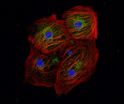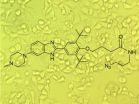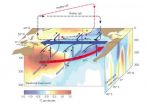(Press-News.org) BUFFALO, N.Y. — In the winter, brown and black bears go into hibernation to conserve energy and keep warm.
But things are different for their Arctic relative, the polar bear. Within this high-latitude species, only pregnant females den up for the colder months.
So how do the rest survive the extreme Arctic winters?
New research points to one potential answer: genetic adaptations related to the production of nitric oxide, a compound that cells use to help convert nutrients from food into energy or heat.
In a new study, a team led by the University at Buffalo reports that genes controlling nitric oxide production in the polar bear genome contain genetic differences from comparable genes in brown and black bears.
"With all the changes in the global climate, it becomes more relevant to look into what sorts of adaptations exist in organisms that live in these high-latitude environments," said lead researcher Charlotte Lindqvist, PhD, UB assistant professor of biological sciences.
"This study provides one little window into some of these adaptations," she said. "Gene functions that had to do with nitric oxide production seemed to be more enriched in the polar bear than in the brown bears and black bears. There were more unique variants in polar bear genes than in those of the other species."
The paper, titled "Polar Bears Exhibit Genome-Wide Signatures of Bioenergetic Adaptation to Life in the Arctic Environment," appeared Feb. 6 in the journal Genome Biology and Evolution. Co-authors include scientists from UB, Penn State University, the U.S.G.S. Alaska Science Center, Durham University and the University of California, Santa Cruz.
The genetic adaptations the research team saw are important because of the crucial role that nitric oxide plays in energy metabolism.
Typically, cells transform nutrients into energy. However, there is a phenomenon called adaptive or non-shivering thermogenesis, where the cells will produce heat instead of energy in response to a particular diet or environmental conditions.
Levels of nitric oxide production may be a key switch triggering how much heat or energy is produced as cells metabolize nutrients, or how much of the nutrients is stored as fat, Lindqvist said.
"At high levels, nitric oxide may inhibit energy production," said Durham University's Andreanna Welch, PhD, first author and a former postdoctoral researcher at UB with Lindqvist. "At more moderate levels, however, it may be more of a tinkering, where nitric oxide is involved in determining whether — and when — energy or heat is produced."
The research is part of a larger research program devoted to understanding how the polar bear has adapted to the harsh Arctic environment, Lindqvist said.
In 2012, she and colleagues reported sequencing the genomes of multiple brown bears, black bears and polar bears.
In a paper in the Proceedings of the National Academy of Sciences, the team said comparative studies between the DNA of the three species uncovered some distinctive polar bear traits, such as genetic differences that may affect the function of proteins involved in the metabolism of fat — a process that's very important for insulation.
In the new study, the scientists looked at the mitochondrial and nuclear genomes of 23 polar bears, three brown bears and a black bear.
INFORMATION:
The research was funded by the University at Buffalo and the National Fish and Wildlife Foundation.
How do polar bears stay warm? Research finds an answer in their genes
New study is part of a broader genomic research program aimed at understanding what makes a polar bear a polar bear
2014-02-10
ELSE PRESS RELEASES FROM THIS DATE:
Experimental care program keeps people with dementia at home longer, study shows
2014-02-10
An 18-month pilot program that brought resources and counselors to elderly Baltimore residents with dementia and other memory disorders significantly increased the length of time they lived successfully at home, according to Johns Hopkins researchers. Staying at home was a clear preference for most of those who participated in the study.
"The project demonstrated that we were able to help such people age in place without sacrificing their quality of life," says study leader Quincy Miles Samus, Ph.D., an assistant professor of psychiatry and behavioral sciences at the ...
Research reveals the give and take of urban temperature mitigating technologies
2014-02-10
TEMPE, Ariz. – Life in a warming world is going to require human ingenuity to adapt to the new realities of Earth. Greenhouse-gas induced warming and megapolitan expansion are both significant drivers of our warming planet. Researchers are now assessing adaptation technologies that could help us acclimate to these changing realities.
But how well these adaptation technologies – such as cool roofs, green roofs and hybrids of the two – perform year round and how this performance varies with place remains uncertain.
Now a team of researchers, led by Matei Georgescu, ...
The genetic origins of high-altitude adaptations in Tibetans
2014-02-10
Genetic adaptations for life at high elevations found in residents of the Tibetan plateau likely originated around 30,000 years ago in peoples related to contemporary Sherpa. These genes were passed on to more recent migrants from lower elevations via population mixing, and then amplified by natural selection in the modern Tibetan gene pool, according to a new study by scientists from the University of Chicago and Case Western Reserve University, published in Nature Communications on Feb. 10.
The transfer of beneficial mutations between human populations and selective ...
Study involving twin sisters provides clues for battling aggressive cancers
2014-02-10
CINCINNATI – Analyzing the genomes of twin 3-year-old sisters – one healthy and one with aggressive leukemia – led an international team of researchers to identify a novel molecular target that could become a way to treat recurring and deadly malignancies.
Scientists in China and the United States report their findings online Feb. 9 in Nature Genetics. The study points to a molecular pathway involving a gene called SETD2, which can mutate in blood cells during a critical step as DNA is being transcribed and replicated.
The findings stem from the uniquely rare opportunity ...
Genome editing goes hi-fi
2014-02-10
SAN FRANCISCO, CA—February 9, 2014—Sometimes biology is cruel. Sometimes simply a one-letter change in the human genetic code is the difference between health and a deadly disease. But even though doctors and scientists have long studied disorders caused by these tiny changes, replicating them to study in human stem cells has proven challenging. But now, scientists at the Gladstone Institutes have found a way to efficiently edit the human genome one letter at a time—not only boosting researchers' ability to model human disease, but also paving the way for therapies that ...
Cochlear implants -- with no exterior hardware
2014-02-10
Cochlear implants — medical devices that electrically stimulate the auditory nerve — have granted at least limited hearing to hundreds of thousands of people worldwide who otherwise would be totally deaf. Existing versions of the device, however, require that a disk-shaped transmitter about an inch in diameter be affixed to the skull, with a wire snaking down to a joint microphone and power source that looks like an oversized hearing aid around the patient's ear.
Researchers at MIT's Microsystems Technology Laboratory (MTL), together with physicians from Harvard Medical ...
Scientists invent advanced approach to identify new drug candidates from genome sequence
2014-02-10
JUPITER, FL—February 9, 2014—In research that could ultimately lead to many new medicines, scientists from the Florida campus of The Scripps Research Institute (TSRI) have developed a potentially general approach to design drugs from genome sequence. As a proof of principle, they identified a highly potent compound that causes cancer cells to attack themselves and die.
"This is the first time therapeutic small molecules have been rationally designed from only an RNA sequence—something many doubted could be done," said Matthew Disney, PhD, an associate professor at TSRI ...
Fight or flight? Vocal cues help deer decide during mating season
2014-02-10
Previous studies have shown that male fallow deer, known as bucks, can call for a mate more than 3000 times per hour during the rut (peak of the mating season), and their efforts in calling, fighting and mating can leave them sounding hoarse.
In this new study, published today (10 February) in the journal Behavioral Ecology, scientists were able to gauge that fallow bucks listen to the sound quality of rival males' calls and evaluate how exhausted the caller is and whether they should fight or keep their distance.
"Fallow bucks are among the most impressive vocal athletes ...
Pacific trade winds stall global surface warming -- for now
2014-02-10
Heat stored in the western Pacific Ocean caused by an unprecedented strengthening of the equatorial trade winds appears to be largely responsible for the hiatus in surface warming observed over the past 13 years.
New research published today in the journal Nature Climate Change indicates that the dramatic acceleration in winds has invigorated the circulation of the Pacific Ocean, causing more heat to be taken out of the atmosphere and transferred into the subsurface ocean, while bringing cooler waters to the surface.
"Scientists have long suspected that extra ocean ...
Seven new genetic regions linked to type 2 diabetes
2014-02-10
Seven new genetic regions associated with type 2 diabetes have been identified in the largest study to date of the genetic basis of the disease.
DNA data was brought together from more than 48,000 patients and 139,000 healthy controls from four different ethnic groups. The research was conducted by an international consortium of investigators from 20 countries on four continents, co-led by investigators from Oxford University's Wellcome Trust Centre for Human Genetics.
The majority of such 'genome-wide association studies' have been done in populations with European ...
LAST 30 PRESS RELEASES:
Making lighter work of calculating fluid and heat flow
Normalizing blood sugar can halve heart attack risk
Lowering blood sugar cuts heart attack risk in people with prediabetes
Study links genetic variants to risk of blinding eye disease in premature infants
Non-opioid ‘pain sponge’ therapy halts cartilage degeneration and relieves chronic pain
AI can pick up cultural values by mimicking how kids learn
China’s ecological redlines offer fast track to 30 x 30 global conservation goal
Invisible indoor threats: emerging household contaminants and their growing risks to human health
Adding antibody treatment to chemo boosts outcomes for children with rare cancer
Germline pathogenic variants among women without a history of breast cancer
Tanning beds triple melanoma risk, potentially causing broad DNA damage
Unique bond identified as key to viral infection speed
Indoor tanning makes youthful skin much older on a genetic level
Mouse model sheds new light on the causes and potential solutions to human GI problems linked to muscular dystrophy
The Journal of Nuclear Medicine ahead-of-print tip sheet: December 12, 2025
Smarter tools for peering into the microscopic world
Applications open for funding to conduct research in the Kinsey Institute archives
Global measure underestimates the severity of food insecurity
Child survivors of critical illness are missing out on timely follow up care
Risk-based vs annual breast cancer screening / the WISDOM randomized clinical trial
University of Toronto launches Electric Vehicle Innovation Ontario to accelerate advanced EV technologies and build Canada’s innovation advantage
Early relapse predicts poor outcomes in aggressive blood cancer
American College of Lifestyle Medicine applauds two CMS models aligned with lifestyle medicine practice and reimbursement
Clinical trial finds cannabis use not a barrier to quitting nicotine vaping
Supplemental nutrition assistance program policies and food insecurity
Switching immune cells to “night mode” could limit damage after a heart attack, study suggests
URI-based Global RIghts Project report spotlights continued troubling trends in worldwide inhumane treatment
Neutrophils are less aggressive at night, explaining why nighttime heart attacks cause less damage than daytime events
Menopausal hormone therapy may not pose breast cancer risk for women with BRCA mutations
Mobile health tool may improve quality of life for adolescent and young adult breast cancer survivors
[Press-News.org] How do polar bears stay warm? Research finds an answer in their genesNew study is part of a broader genomic research program aimed at understanding what makes a polar bear a polar bear








